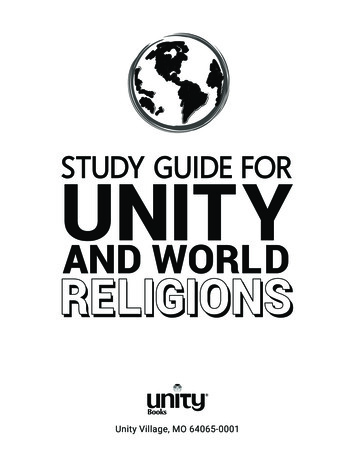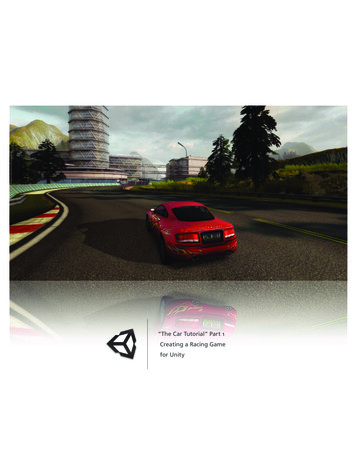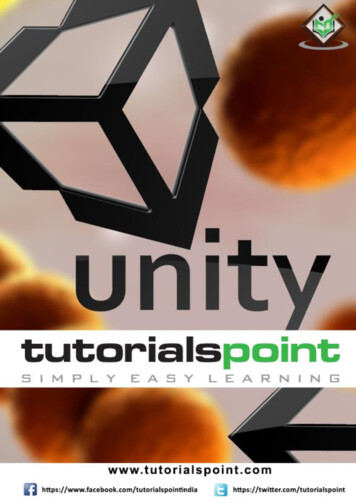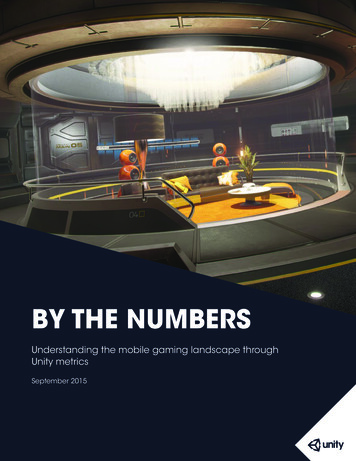
Transcription
STUDY GUIDE FORUNITYAND WORLDRELRELIIGIONSRELIGIONSUnity Village, MO 64065-0001
This page is intentionally left blank.
F R O M T H E D E S K O F R E V. PA U L J O H N R O A C HThis simple study guide may be used individually, for discussionin small groups, or as a class study. The questions are designedto evoke deep reflection on your own spiritual understandings.Reading about world religions may be interesting, but they take ongreater meaning when we can enrich our spiritual lives with some oftheir teachings and practices. What new awareness of the Divine dothey evoke in you? It is always helpful to have a journal handy to writedown your thoughts and ideas, especially for individual study.The questions pertaining to each chapter from the book are based onfive prompts: Reflect: Contemplate the core of your spiritualunderstanding. Refine: Examine how the teachings in this bookhave deepened, changed, or reinforced yourunderstanding of Truth. Connect: Bring your awareness to the goldenthread that connects world religions and theinterconnectedness of creation and the creativeprocess. Affirm: Decide what is true for you, and clearly affirmand declare it. Act: Explore ways to put what you know into practice.These are loosely based on the five Truth principles reflectedthroughout the book and taught in Unity. Principle One: God is Absolute Good, everywherepresent, the one presence and one power in theuniverse.3
Principle Two: Human beings have a spark ofdivinity within them, the Christ spirit within. Theirvery essence is of God, and therefore they are alsoinherently good. Principle Three: Human beings create theirexperiences by the activity of their thinking.Everything in the manifest realm has its beginning inthought. Principle Four: Prayer is creative thinking thatheightens the connection with God-Mind andtherefore brings forth wisdom, healing, prosperity,and everything good. Principle Five: Knowing and understanding the lawsof life, also called Truth, are not enough. We mustalso live the truth we know.As you approach each question, open your mind and heart tothe intuitive wisdom and emotional intelligence within yourself.Intellectual study can be rewarding, but real transformation comesfrom contacting the core of deep wisdom and love within you.May this study guide deepen your knowledge and understanding ofthe world’s religions and the connections among them. May it alsoserve you on your personal spiritual journey.Enjoy the adventure!Rev. Paul John RoachRev. Paul John RoachPS: Feel free to make copies of this study guide for classes or small groups.4
I NTRODUCTIO NNTRODUCTIONTo prepare for this work, consider where you are spiritually right now.ReflectTake time to reflect upon your own spiritual journey. How has it unfolded? Doyou recall any tipping points or shifts in your awareness? How would you describeyourself in spiritual terms at this point in your life?RefineThink about the five essential Truth principles taught in Unity. Are there one ortwo that specifically appeal to you?ConnectIdentify any spiritual techniques or tools that are helpful in your life. Whilestudying this book, identify others you might want to explore, including thosefrom world religions.5
INTRODUCTION CONTINUEDAffirmConsider what prayer means to you. How do you pray?ActIn your everyday life, how do you practice the spiritual truths that you know?Notes:6
CH APTER ONEAPTERUNITY AND CHRISTIANITYReflectTake a moment to reflect on your relationship with Jesus and what the natureof the Christ means to you. What is your present understanding, and how do youinterpret their interconnection?RefineWhat, for you, is the difference between the teachings of Jesus and the teachingsabout Jesus?ConnectDescribe the ways in which you connect to God or divine presence. Can theword God or other religious terms become barriers to your spiritual growth?7
CHAPTER ONE: UNITY AND CHRISTIANITY CONTINUEDAffirmFind and write down Bible quotations that support your spiritual practice.ActFollowing Jesus’ command to “love one another,” contemplate ways to do that.Challenge yourself to replace fear and anxiety with love and compassionateaction.Notes:8
CH A PTE R T WOUNITY AND JUDAISMReflectJewish history has been one of perseverance against difficult odds. Consider someof the spiritual qualities that are helpful in dealing with your own difficulties.RefineJudaism practices a full-spectrum approach to life, the universe, and one’s placein it. How does that compare to your own spiritual approach? Does your spiritualpractice cover all areas of your life?ConnectDo you find value in the covenants with God made by the Jews? Consider Charlesand Myrtle Fillmore’s own dedication and covenant. What would your ownpersonal covenant look like?9
C H A P T E R T W O: U N I T Y A N D J U D A I S M C O N T I N U E DAffirmGod is One is a powerful affirmation. Explore how God can be both above all andwithin all. Does one appeal to you more? How can you use this understanding inyour daily life?ActJewish tradition talks about healing or mending the world. Do you believe itneeds mending or healing? If so, what are some of the ways you could helpachieve that?Notes:10
CH APTEAP TE R THREEUNITY AND ISLAMReflectTake time to reflect on the dramatic tensions that exist in Islam and otherreligions between love and judgment, or righteous struggle and peace. How canthese apparent dichotomies be reconciled?RefineIslam has a highly structured set of beliefs and practices. Unity is much lessstructured. What do you see as the advantages and disadvantages of bothapproaches?ConnectIslam is often misunderstood by non-Muslims. Can you find commonalitiesbetween Islam and your own spiritual path?11
CHAPTER THREE: UNITY AND ISLAM CONTINUEDAffirmMuslim prayer is very God-centered. How does that compare to your ownapproach to prayer and the Divine?ActThe Muslim tradition offers specific guidance for putting one’s faith into action.Which of the Five Pillars of Islam appeal to you? How can you use these teachingsto better your life?Notes:12
CH AP TERTE R F OURUNITY AND HINDUISMReflectReflect on the Hindu idea that God is formless and takes many forms. What isyour understanding of this?RefineHinduism could be described as highly eclectic and all-encompassing, yet itretains a core identity. Is this true of Unity or your own spiritual path? What isthe core for you?ConnectThe goal of Hinduism is moksha or freedom. What does this mean to you, andhow might you obtain it?13
CHAPTER FOUR: UNITY AND HINDUISM CONTINUEDAffirmHinduism has many great affirmative statements and mantras. Create a mantraand practice using it on a daily basis.ActAre there specific teachings or practices in Hinduism that particularly appealto you? If so, which ones and why? Do you see a way to use these teachings orpractices to benefit others?Notes:14
CH APTE R F I VEAPTERUNITY AND BUDDHISMReflectDoes the Buddha’s response to suffering make sense to you? What have youlearned from times of suffering in your own life?RefineThe Buddha realized personal pleasures did not bring lasting joy and found adeeper purpose in life. Examine your own purpose for living. What brings youjoy?ConnectHow do you relate to the idea of no-self? Likewise, how do you relate to the ideaof Buddha nature? Can they coexist?15
CHAPTER FIVE: UNITY AND BUDDHISM CONTINUEDAffirmEmptiness and spaciousness are key concepts in Buddhist teachings. What wouldyour meditation practice look like using these concepts?ActBuddhism places great emphasis on generosity and compassion. How can youemphasize these qualities in your interactions? What does this look like?Notes:16
CH A PTE R SI XUNITY AND TAOISMReflectIs it true that what cannot be named is often closer to ultimate Truth than whatis described or defined? In other words, do language or labels sometimes get inthe way of direct experience?RefineThe soft overcoming the hard is a central idea in Taoism. Does this idea appealto you? If so, or if not, why?ConnectYin and yang have become well-known terms in the West in recent years. Whatdo they mean for you? How can they inform your practice?17
C H A P T E R S I X : U N I T Y A N D TA O I S M C O N T I N U E DAffirmDo you have a favorite verse from the Tao Te Ching? Can you express the essenceof it in your own words?ActThe Tao says there is nothing to perfect. Can you find comfort in who you areand act with confidence?Notes:18
CH APTE R SE VE NAPTERSMORGASBORDReflectHow do the ideas of the Perennial Philosophy and the golden thread within allreligions help you navigate the smorgasbord of humankind’s many approachesto the Divine?RefineMost spiritual traditions honor creation and nature in some way. How do you livefrom the divine order of creation, the natural world, and the creativity withinyou?ConnectGiven the multiplicity of paths, practices, and techniques available in religion,which ones feel right for you?19
CHAPTER SEVEN: SMORGASBORD CONTINUEDAffirmLove is the foundation for all religions. How do you express love?ActIf you had a message for all people, what would it be?Notes:20
CONCLUSI ONTHE FUTURE OF RELIGIONReflectThe book mentions inequality, artificial intelligence, and climate change as issuesaffecting the future of religion. How do you see these issues affecting religion?Are there others you can name?RefineWhat does the term “spiritual but not religious” mean to you?ConnectHow do we honor the world’s ancient religious traditions while remaining opento new ideas unfolding in the modern world?21
CONCLUSION: THE FUTURE OF RELIGION CONTINUEDAffirmLooking toward the future, what affirmation would you create and teach to yourchildren and grandchildren?ActWhat personal commitment are you prepared to make to bring what you believeinto practice?Notes:22
NOTEN OTE SABUNDANTBLESSINGS,Rev. Paul John RoachRev. Paul John Roach23
Refine: Examine how the teachings in this book have deepened, changed, or reinforced your understanding of Truth. Connect: Bring your awareness to the golden thread that connects world religions and the interconnectedness of creation and the creative process. Affirm: Decide what is true for you, and clearly affirm and declare it.











